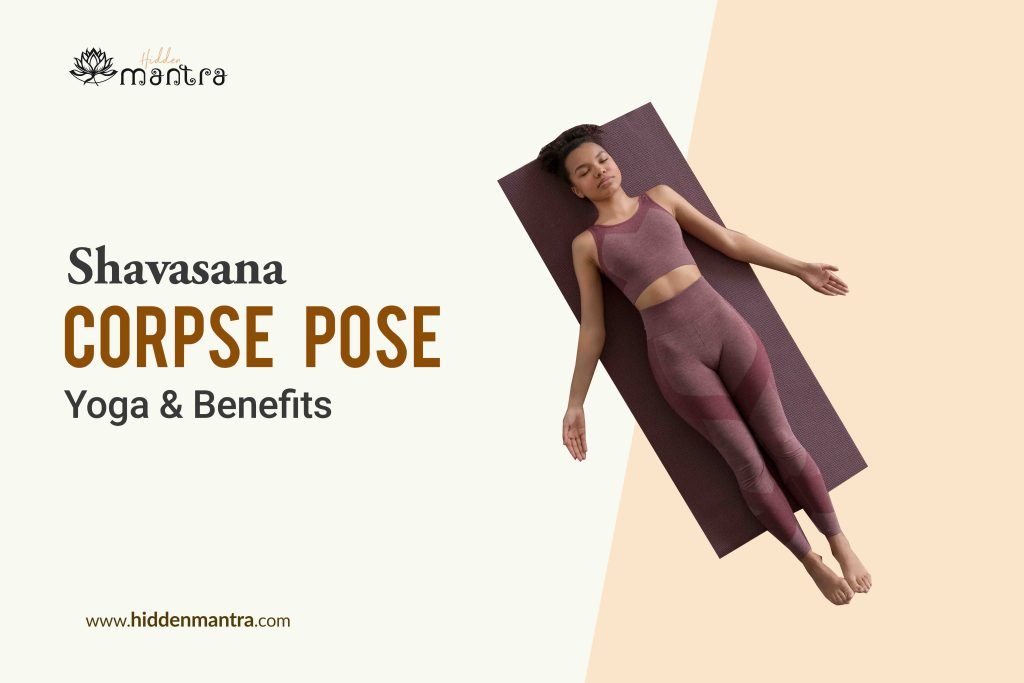Welcome to the peaceful world of classical yoga, a practice that is open to all. Today, we will explore Shavasana, also known as the Corpse Pose. This timeless pose embodies the essence of peace within the ancient tradition of yoga.
Shavasana invites you to lie down, relax, and experience a deep sense of stillness. It’s like taking a peaceful pause from the busyness of life to connect with the ancient wisdom of yoga.
As we explore Shavasana, you’ll not only discover its simple yet profound physical benefits but also its ability to bring a sense of calm to your mind and spirit. So, let’s embark on this journey and experience the blissful serenity that classical yoga, through Shavasana, offers to practitioners of all backgrounds.
Shavasana (Corpse Pose) Meaning
The term “Shavasana” is derived from Sanskrit, the ancient language of yoga. Here’s the meaning of “Shavasana” broken down:
Shava
The word “Shava” (शव) translates to “corpse” in Sanskrit.
Asana
The term “Asana” (आसन) means “pose” or “posture.”
So, when you combine these factors, “Shavasana” can be understood as the “Corpse Pose.” In Shavasana, you lie down on your back in a relaxed and motionless position, similar to a peaceful and resting corpse. This pose represents the ultimate relaxation and surrender, allowing both the body and mind to experience deep stillness and rejuvenation.
Shavasana (Corpse Pose) Yoga Benefits:
- Stress Reduction – Shavasana is a powerful antidote to stress. It allows the body and mind to fully relax, reducing tension and anxiety.
- Improved Sleep – Regular practice of Shavasana can promote better sleep patterns and help with insomnia, ensuring a more restful night’s rest.
- Mental Clarity – This pose enhances mental focus and clarity by providing a tranquil space for the mind to unwind and rejuvenate.
- Lower Blood Pressure – Shavasana’s calming effect on the nervous system can help regulate blood pressure, promoting heart health.
- Muscle Relaxation – It releases physical tension, easing muscle aches and pains throughout the body.
- Enhanced Body Awareness – Shavasana cultivates mindfulness and awareness, fostering a deeper connection between the body and mind.
- Reduced Fatigue – Regular practice can alleviate fatigue, leaving you feeling more energized and refreshed.
- Improved Breathing – Shavasana encourages deep, diaphragmatic breathing, enhancing lung function and oxygenating the body.
- Emotional Balance – It promotes emotional stability and resilience, helping you navigate life’s challenges with a sense of equanimity.
- Spiritual Connection – Some practitioners find that Shavasana allows them to access a deeper sense of spiritual or inner peace.
How to Do Shavasana (Corpse Pose)
Shavasana, also known as the Corpse Pose, is a simple yet deeply relaxing yoga pose. Follow these steps to practice it:
- Preparation – Find a quiet and peaceful space to practice. Use a yoga mat or a comfortable surface like a carpet.
- Lie Down – Start by lying down on your back. Extend your legs comfortably and let them fall open. Your feet should be relaxed with toes naturally falling to the sides.
- Arms Placement – Place your arms alongside your body, slightly away from your torso. Keep your palms facing upward, and let your fingers naturally curl.
- Head and Neck – Allow your head to rest gently on the mat. Make sure your neck is in a neutral position, neither lifted nor pressed into the floor.
- Close Your Eyes – Softly close your eyes. This signals to your body that you’re ready to relax.
- Focus on Breath – Take a few deep breaths to centre yourself. Inhale and exhale slowly and consciously.
- Relax Every Body Part – Starting from your toes, consciously relax each part of your body. Release any tension as you work your way up through your legs, torso, arms, neck, and head.
- Clear Your Mind – Let go of any thoughts or worries. Focus on your breath or a mental image of a serene place.
- Stay in Shavasana – Remain in this relaxed state for at least 5-10 minutes, or longer if you like. Feel a profound sense of calm and rejuvenation.
- Awakening – To exit, slowly bring awareness back to your body. Wiggle your fingers and toes, and gently stretch your arms overhead.
- Roll to Your Side – Turn onto your right side in a fetal position, keeping your eyes closed.
- Return to Sitting – Use your hands to help you sit up slowly.
Shavasana is a practice of complete surrender and relaxation. It’s a wonderful way to conclude your yoga session, allowing the benefits of your practice to integrate deeply into your body and mind.
Variations of Shavasana (Corpse Pose)
Supported Shavasana
Place a folded blanket or cushion under your knees to relieve pressure on the lower back. This variation is especially helpful for those with lower back discomfort.
Legs Up the Wall (Viparita Karani)
Scoot your hips close to a wall and extend your legs upward. This variation is excellent for promoting circulation and relieving tired legs.
Corpse Pose with Deep Breathing
Inhale and exhale deeply and slowly as you practice Shavasana. Focus on the rise and fall of your abdomen with each breath, enhancing relaxation.
Visualizations
During Shavasana, engage in guided visualizations or mental journeys to deepen your relaxation. Imagine a tranquil beach, a peaceful forest, or any serene place that resonates with you.
Sound Healing
Listen to soothing music or recorded chants during Shavasana to enhance the meditative experience.
Blanket Cocoon
Cover yourself with a light blanket to create a cocoon-like sensation, enhancing the feeling of comfort and security.
Meditative Shavasana
Combine Shavasana with a brief meditation practice. Focus on your breath or repeat a calming mantra silently.
Props for Support
Use props like an eye pillow, neck roll, or bolster to enhance comfort and relaxation during Shavasana.
These variations allow you to customize your Shavasana experience, making it even more nurturing and restorative. Experiment with different options to find what resonates best with your body and mind.
Conclusion:
In the practice of Shavasana, we’ve uncovered a simple yet profound gem from classical yoga. This Corpse Pose reminds us of the importance of rest and rejuvenation. As we lie in stillness, we tap into the power of calmness, offering solace to body, mind, and spirit. Shavasana, often reserved for the end of a yoga session, reflects the holistic nature of yoga, where physical and spiritual dimensions converge.
By embracing Shavasana regularly, we invite peace and serenity. Explore more yoga wisdom on our blog, “Hidden Mantra,” and let Shavasana guide you toward a harmonious and balanced life. Namaste!!!









